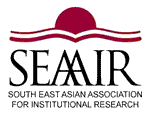| Welcome to SEAAIR |
 |
 |
| Home | About SEAAIR | Journal | Conference Info | Memberships | Others | Contact SEAAIR |
| |||||||||||||
| |||||||||||||
|
|
|
Important Protocols and Instructions:
Developing Entrepreneurship Competency Measures for Higher Education
In the era of globalization, graduates of higher education have to be able to meet global job requirements. This means that they are expected to be relevant to the users of their services, to their country and even to the world. So, they need to have fitness for purpose or quality, relevant discipline areas, enterprising and professional commitment.
The aim of this research is to identify the entrepreneurship competency factors required to produce such graduates. We contend that these factors will require the higher education institutions to appropriately improve their curricula and their learning processes and through these enhance their own entrepreneurial capacity and ability.
Several generic competency models are investigated and include a generic, cross-cultural competency that measures:
The samples for this study were taken from Widyatama, Padjadjaran and Bina Nusantara Universities in Indonesia and Wenzhou University in China.
Keywords: Development of entrepreneur competency
Nirwan Idrus
nidrus@es.co.nz
Universities including their Faculties or Schools of Business or Management are behind the industries they serve. In many cases they have been advising their industry clients to do things that they themselves do not practice. The unique complexity of university organization, the idiosyncratic nature of its human resources, the multiplicity of its stakeholders and the sometimes-enormous inertia to be overcome in order to change itself, add to the challenges of developing a quality and enterprising institution. Much has been written and published about how this could be done, but very little evidence of success is available.
ISO 9000 series, EFQM (European Foundation for Quality Management) and Malcolm Baldrige Award’s criteria have been and are still being used by various universities to gain the recognition of being a quality institution.
However, a correct first step is very necessary in order to sustain the endeavour towards developing such a university. This paper proposes a perception gaps analysis as the first step. This is obtained from comparing the importance and performance of selected factors about the university and then finding and implementing ways to close these gaps. To test the front end of the method, a survey of about 800 students and 40 senior academic staff in 13 state universities and polytechnics across Indonesia was carried out. The result validates the method. Effective subsequent steps could then be developed efficiently in an appropriate priority order.
Lina Lu
Email: lul@pdx.edu
Each year, thousands of America’s community college students transfer to four-year institutions. Due to the differences of educational environments and academic expectations between two- and four-year institutions, most transfer students experienced transfer shock, a dip in transfer students’ academic performance in the first or second semester after transferring. In order to smooth the transfer process, these two tiers of higher education have worked in partnership to develop more programs to ease any possible transfer shock that students might experience. One of these programs is co-admissions by both two- and four-year institutions. The co-admission program established by Portland State University and local community colleges provides co-admitted students with access to enrollment in classes, advising, library, computer services, and social activities at both campuses. Is this co-admission program beneficial to transfer students? This study examined academic performance of the co-admission program students, using such measures as term credit hours and GPA, academic standing, and fall-to-fall retention. It also compared educational progress of co-admission program students with non co-admission community college transfer students, in terms of graduation rates, cumulative credit hours to degree, degree GPA, time to degree. The results of the study showed that compared to their peers, the co-admission program students held better GPA, higher retention rates, and higher six-year graduation rates. Discussions and implications are also provided at the end of the paper.